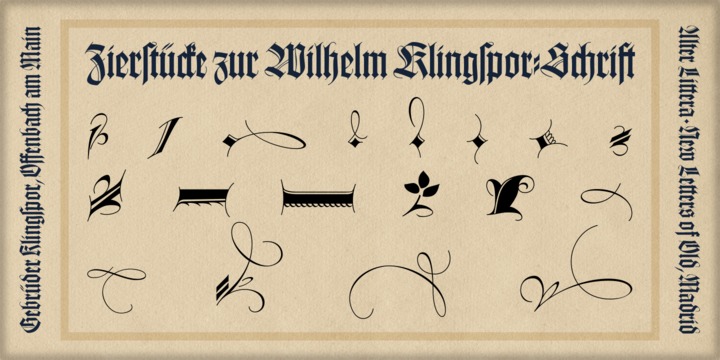Wilhelm Klingspor Schrift We are and so proud to introduce our very best font to you. This Wilhelm Klingspor Schrift is the successful outcomes of our company trial regarding font invention that will satisfy the customer and provide the better result in comparison with any font in the marketplace nowadays.
Not only the fact it is the high quality solution from high quality graphic that can generate the enjoy outcome from our corporation lab but the feedback from our real users of this Wilhelm Klingspor Schrift are also just as by being the good feedback.
Our website is offered to provide the full information details for you 1 day per day so that you can appreciate seeking for the information prior to decision to use your Wilhelm Klingspor Schrift . Not only the elegant information about the font on our website is provides but the reviews from authentic users are seemed on internet to give genuine feedback from real users about our own Wilhelm Klingspor Schrift .
This is valuable to suit your needs because it can help you to produce decision to use each of our Wilhelm Klingspor Schrift or not and it’s the true feedback from real users with no adjusting or making up in the positive feedback. Don’t wait to try our important font and you will understand why we recommend it to you.
Download Wilhelm Klingspor Schrift Font Family Now
A comprehensive and faithful rendition of one of the finest metal typefaces of the 20th century. Rudolf Koch designed Wilhelm Klingspor Schrift (initially conceived as Missal Schrift, and later referred to also as Wilhelm Klingspor Gotisch) between 1919 and 1925 for the Gebr. Klingspor Type Foundry in Offenbach am Main. It is an impressive textura typeface, being sharp, elegant, spiky, sensitive and noble at the same time. Some of its most notable features have to do with the delicate decorations, the thin but subtly swelling lines that parallel or bridge strokes in the capitals, the hairline endings that terminate each stroke in both the capitals and the lowercase letters, the subtle joining of hairlines to thicker strokes, and the tension of some of the transitional curves. More Kochs original design included two sets of capitals (normal and condensed); alternates for a, d, e, r, s and z, plus long s; short and long flourished finial forms for f and t; thirty-five ligatures; and eighteen decorative pieces (Zierstcke). All of these features, plus several additional ones for modern use (including the usual standard characters for typesetting in modern Western languages, additional alternates and ligatures, plus carefully coded Opentype features), have been thoroughly implemented to the highest and most lively level of detail in the present font, in the hope that the past greatness of Wilhelm Klingspor Schrift will finally step into the modern OpenType realm. The main sources used during the font design process were several pages from a specimen book issued by the Gebr. Klingspor Type Foundry in 1927. Other sources were as follows: Bain, P., and Shaw, P. (Eds.) (1998), Blackletter: Type and National Identity, New York: Princeton Architectural Press (p. 43); Hendlmeier, W. (1994), Kunstwerke der Schrift, Hannover: Bund fr Deutsche Schrift und Sprache (pp. 56-7); Kapr, A. (1983), Schriftkunst, Dresden: VEB Verlag der Kunst (p. 453); Kapr, A. (1993), Fraktur - Form und Geschichte der gebrochenen Schriften, Mainz: Verlag Hermann Schmidt (pp. 124-5); and Klingspor, K. (1949), ber Schnheit von Schrift und Druck, Frankfurt am Main: Georg Kurt Schauer (pp. 136-7). Some public and private comments by renowned designer and design historian Paul Shaw have also influenced both the design and the description of the present font. Specimen, detailed character map, OpenType features, and font samples available at Alter Litteras The Oldtype Wilhelm Klingspor Schrift Font Page.
